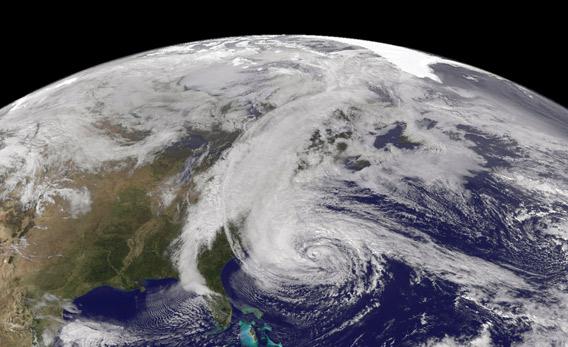Climate scientist Kerry Emanuel of MIT calls Hurricane Sandy a hybrid storm, a rare type that scientists don’t know much about. He says its damaging rainfall is the sort of thing we’ll see more of in the future due to climate change.
Lisa Palmer: Some scientists say Sandy’s enormous size is not related to climate change. Others say that all storms now have a global warming component because climate change has altered the background state. What does the science say?
Kerry Emanuel: It is correct to say that in no individual [weather] event can you really make an attribution to anything, whether it is climate change or El Nino or your grandmother had her tooth pulled this morning. You just can’t do it for a single event. It is just the nature of the game. Now, Sandy is an example of what we call a hybrid storm. It works on some of the same principles as the way hurricanes work but it also works on the same principles as winter storms work. Hurricanes and winter storms are powered by completely different energy sources. The hurricane is powered by the evaporation of sea water. Winter storms are powered by horizontal temperature contrasts in the atmosphere. So hybrid storms are able to tap into both energy sources. That’s why they can be so powerful.
LP: What do we know about climate change and hybrid events?
KE: My profession has not compiled a good climatology of hybrid events. We have fantastic climatology of hurricanes, but we don’t have a good climatology of hybrid events. It is really because we haven’t done our homework. We don’t have very good theoretical or modeling guidance on how hybrid storms might be expected to change with climate. So this is a fancy way of saying my profession doesn’t know how hybrid storms will respond to climate. I feel strongly about that. I think that anyone who says we do know that is not giving you a straight answer. We don’t know. Which is not to say that they are not going to be influenced by climate, it’s really to say honestly we don’t know. We haven’t studied them enough. It’s not because we can’t know, it is just that we don’t know.
LP: Is hurricane season going to last longer with climate change?
KE: No, I don’t think so. I mean there are indications in both directions, but nothing I’ve looked at shows major shifts in the season of hurricanes. It doesn’t mean that it isn’t going to change, but the best estimates we are making are only slight changes in the seasonality of storms.
LP: What is the biggest climate change-related factor with storms like Sandy?
KE: With Sandy, a big factor is the coastal waters. For whatever reason, coastal waters are warmer than normal this year. That means that there is more water vapor in the atmosphere. Sandy will certainly produce more rain than if we didn’t have these warm waters near the shore. So you can say that. One of the very definite predictions of climate research is that all storms, regardless of exactly what kind of storm, should rain more going forward because there is just more water vapor in the atmosphere when it gets warmer. And that’s a big deal because of freshwater floods. The second greatest hurricane disaster in the whole Western Hemisphere was the hurricane of 1998 [Hurricane Mitch], and that was all freshwater flooding. It wasn’t wind or even storm surge that caused damage. It was 11,000 people taken out by flash floods in Central America. Don’t underestimate the rain part of it. We think of hurricanes as wind storms and maybe surges, but the rain is a big deal.
